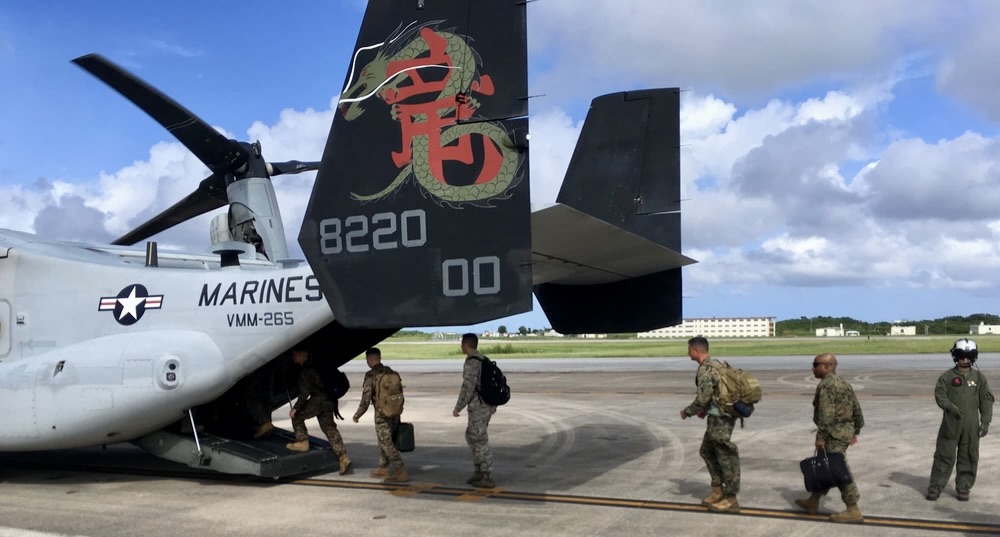
A Joint Humanitarian Assistance Survey Team (JHAST) boards an MV-22 Osprey aircraft during Philippine Amphibious Landing Exercise 33 in 2016. (Marine Corps/Maj. Roger Hollenbeck)
SYDNEY — The Japanese V-22 Osprey fleet, the newest in the world, has not been affected by the hard clutch problem that led to the grounding of many American V-22s, a senior US defense official tells Breaking Defense — but that doesn’t mean the aircraft won’t need replacement parts in the future.
The official, speaking to Breaking Defense during a visit to Australia, also revealed new details about why the US Marine Corps decided to order a flight-stop for a chunk of its Osprey fleet, months after it downplayed a similar move by the US Air Force as unnecessary.
On Feb. 4, the Pentagon announced it was grounding an undefined “subset” of the Osprey fleet, used by the Marine Corps, Navy and Air Force, due to wear on an engine part known as the “input quill assembly,” which connects the aircraft’s engine to the drive system. It had not previously stated if the Japanese Ospreys were impacted by the ground stop.
The Japanese have a fleet of 17 Ospreys, which they began receiving in July 2020 so they have relatively few hours compared to the majority of the Marine fleet. That means, the official said, they have never had to stop flying. However, the official would not rule out the need to replace those parts in the future as the Japanese Ospreys take on more flight hours.
A request for comment to the Japanese government was not returned by press time.
The official expressed satisfaction for the pace at which V-22s were being put back into fighting shape, with planes being cleared for flight “every month.” However, the official would not provide any numbers about just how many Ospreys were grounded, exactly how quickly they were being returned to flight or how many were back in the air after being fixed.
“In the first 30 days we got better and healthier. Now every month we are getting better and the timeline is being reduced as we speak by an increase in the manufacturing of those parts,” the senior official said. “We have shrunk the timeline by almost 50 percent.” The official noted that the Pentagon has not yet identified the root cause of the problem, but is hard at work both providing a demonstrated fix and is pursuing “four lines of effort and 24 initiatives that are going after a root cause.”
The V-22 program — meaning the Navy, Marine Corps and Air Force variants — have recorded 15 clutch-related incidents since 2010, with 10 of those incidents involving the Marines. None of the 15 incidents occurred on the Navy’s CMV-22 variant.
While the Air Force shut its V-22 fleet down for safety inspections last August, the Marine Corps did not, instead insisting their pilots could compensate for the issue and had been doing so for some time. The sense from Air Force officials was that the Marines weren’t taking the issue seriously.
That seemed to change by February, when the tri-service fleets were all announced as impacted by the ground stop. At the time, officials in DC stated new data was showing an increase in the risks of hard clutch events, but didn’t go into further details. Speaking this month, the senior defense official told Breaking Defense that planners were running two risk models, one that considered the probability of occurrence and one that analyzed the severity of occurrence.
“So,” the senior defense official said, “we observed an increase in the rate of occurrence of hard clutch engagements.” The systems reliability model determined the Marines were seeing more incidents due to a part wearing out at a certain time.
“The data showed us that the rate of occurrence would continue to increase. So the measure that we undertook of the flight limit bulletin, I think, probably is best summed up as that will allow us to not only to stop this increase in the rate of occurrence, but reduce it by 99%,” the senior official said.
Notably, the official stressed that any grounded Marine aircraft could be safely used to respond if needed, thanks both to the data from the models and pilot training. “Our pilots are well trained to handle the drive train problem. They’ve been doing that for years,” the official said.
“We’re ready any time now, for any mission or any task,” the official said. “If our National Commander or our senior leaders had said, Marine Corps, go respond to Turkey, we would have gone and responded to Turkey with MV-22s. If they said, Marine Corps go respond to the Pacific for whatever the disaster may be we’d have airplanes airborne in a matter of hours.”
Marine maintainers and pilots have been kept apprised of the issues and how things are progressing since the grounding was announced and has “provided great feedback.”
The official said senior leaders have “been transparent. We’ve been in direct communication, myself and the engineers with every ready room that flies the V-22.”
The other good news is that the replacement parts are made by more than one company.
“These are not obsolete parts that we’re talking about. So they’re still in production and we did not have to go back to the drawing board and crank up lines that were cold,” the senior official said






















